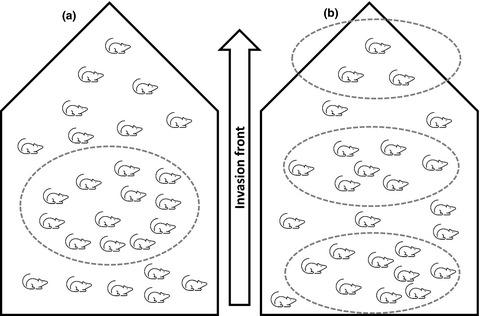当前位置:
X-MOL 学术
›
J. Anim. Ecol.
›
论文详情
Our official English website, www.x-mol.net, welcomes your
feedback! (Note: you will need to create a separate account there.)
Ecoimmunology at spatial scales
Journal of Animal Ecology ( IF 3.5 ) Pub Date : 2020-10-01 , DOI: 10.1111/1365-2656.13296 Kristian M Forbes 1
Journal of Animal Ecology ( IF 3.5 ) Pub Date : 2020-10-01 , DOI: 10.1111/1365-2656.13296 Kristian M Forbes 1
Affiliation

|
IN FOCUS
Becker, D. J., Albery, G. F., Kessler, M. K., Lunn, T. J., Falvo, C. A., Czirják, G. Á., Martin, L. B., & Plowright, R. K. (2020). Macroimmunology: The drivers and consequences of spatial patterns in wildlife immune defence. Journal of Animal Ecology, 89, 972-995. Ecoimmunology seeks to identify and explain natural variation in immune function. Most research so far has focused on differences among individuals within populations, which are often driven by trade-offs in resource allocation between energetically costly immunity and competing processes such as reproduction. In their review article, Becker et al. (2020) have proposed a framework to explicitly address habitat- and population-level differences in wildlife immune phenotypes. Termed macroimmunology, this concept integrates principles from ecoimmunology and macroecology. Becker et al. (2020) have highlighted three non-mutually exclusive habitat features that are likely to vary at spatial scales and influence immune function: (a) parasite pressure, (b) abiotic and biotic factors and (c) anthropogenic changes. However, a large and robust body of literature suitable for synthesis to detect macroimmunology patterns and effect sizes is not yet available. Through their systematic review and critical assessment, Becker et al. (2020) identified common problems in existing research that hinders spatial inferences, such as a need for spatial replication in study design and statistical analyses that account for spatial dependence. Overall, macroimmunology has the potential to identify and even predict spatial patterns in immune phenotypes that form the mechanistic underpinnings of important wildlife disease processes, and this review represents an important step to realizing these goals.
中文翻译:

空间尺度的生态免疫学
焦点 Becker, DJ, Albery, GF, Kessler, MK, Lunn, TJ, Falvo, CA, Czirják, G. Á., Martin, LB, & Plowright, RK (2020)。宏观免疫学:野生动物免疫防御空间模式的驱动因素和后果。动物生态学杂志,89,972-995。生态免疫学旨在识别和解释免疫功能的自然变异。迄今为止,大多数研究都集中在人群中个体之间的差异上,这些差异通常是由高成本的免疫和繁殖等竞争过程之间的资源分配权衡所驱动的。在他们的评论文章中,Becker 等人。(2020)提出了一个框架,以明确解决野生动物免疫表型的栖息地和种群水平差异。这个概念被称为宏观免疫学,它整合了生态免疫学和宏观生态学的原理。贝克尔等人。(2020)强调了三个可能在空间尺度上发生变化并影响免疫功能的非互斥栖息地特征:(a)寄生虫压力,(b)非生物和生物因素以及(c)人为变化。然而,目前还没有大量适用于综合检测宏观免疫学模式和效应大小的文献。通过他们的系统审查和批判性评估,Becker 等人。(2020) 确定了现有研究中阻碍空间推断的常见问题,例如在研究设计和统计分析中需要空间复制来解释空间依赖性。总体而言,宏观免疫学有可能识别甚至预测免疫表型的空间模式,这些模式构成了重要的野生动物疾病过程的机制基础,
更新日期:2020-10-01
中文翻译:

空间尺度的生态免疫学
焦点 Becker, DJ, Albery, GF, Kessler, MK, Lunn, TJ, Falvo, CA, Czirják, G. Á., Martin, LB, & Plowright, RK (2020)。宏观免疫学:野生动物免疫防御空间模式的驱动因素和后果。动物生态学杂志,89,972-995。生态免疫学旨在识别和解释免疫功能的自然变异。迄今为止,大多数研究都集中在人群中个体之间的差异上,这些差异通常是由高成本的免疫和繁殖等竞争过程之间的资源分配权衡所驱动的。在他们的评论文章中,Becker 等人。(2020)提出了一个框架,以明确解决野生动物免疫表型的栖息地和种群水平差异。这个概念被称为宏观免疫学,它整合了生态免疫学和宏观生态学的原理。贝克尔等人。(2020)强调了三个可能在空间尺度上发生变化并影响免疫功能的非互斥栖息地特征:(a)寄生虫压力,(b)非生物和生物因素以及(c)人为变化。然而,目前还没有大量适用于综合检测宏观免疫学模式和效应大小的文献。通过他们的系统审查和批判性评估,Becker 等人。(2020) 确定了现有研究中阻碍空间推断的常见问题,例如在研究设计和统计分析中需要空间复制来解释空间依赖性。总体而言,宏观免疫学有可能识别甚至预测免疫表型的空间模式,这些模式构成了重要的野生动物疾病过程的机制基础,











































 京公网安备 11010802027423号
京公网安备 11010802027423号